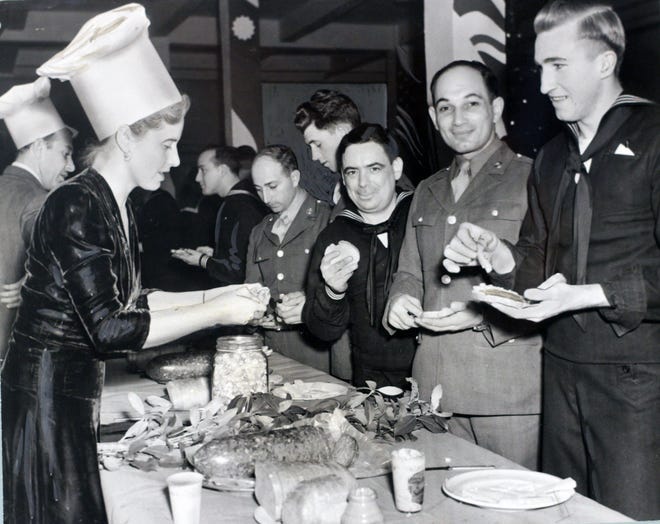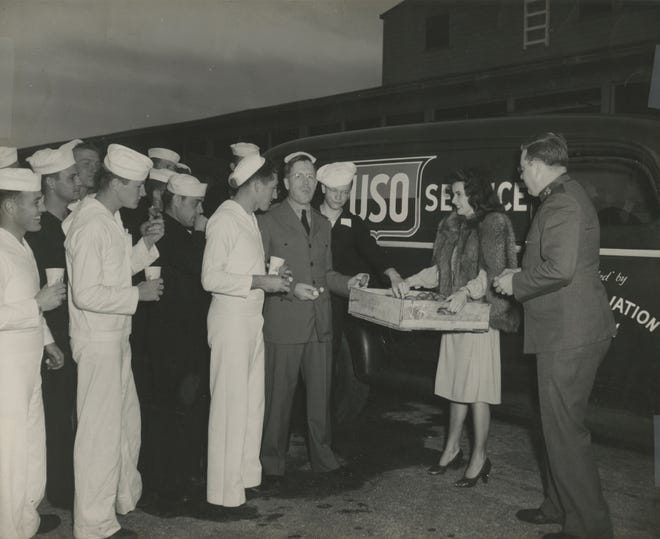Organizations: Real: USO
What a Piece of Work I Am, Chapter 31:
In fact, many of these men, and their women, knew firsthand that they could count on her. They had been the beneficiaries of my grandmother’s goodness. She did a lot of USO work during the Second World War, and when her own firstborn son was killed she threw herself into the work with redoubled vigor, making it her particular charge, a duty she assumed on her own, to lend her shoulder to the mothers, to help prop them up, to give them something of her strength and optimism.
Wikipedia, “United Service Organizations”:
The United Service Organizations Inc. (USO) is an American nonprofit-charitable corporation that provides live entertainment, such as comedians, actors and musicians, social facilities, and other programs to members of the United States Armed Forces and their families. […]
Founded during World War II, the USO sought to be the GI/’s “home away from home” and began a tradition of entertaining the troops and providing social facilities. Involvement in the USO was one of the many ways in which the nation had come together to support the war effort, with nearly 1.5 million people having volunteered their services in some way. […]
The USO was founded on February 4, 1941 by Mary Ingraham in response to a request from President Franklin D. Roosevelt to provide morale and recreation services to U.S. uniformed military personnel. […] This request brought together six civilian organizations: the Salvation Army, YMCA, Young Women's Christian Association (YWCA), National Catholic Community Service, National Travelers Aid Association and the National Jewish Welfare Board. [ ] Roosevelt said he wanted “these private organizations to handle the on-leave recreation of the men in the armed forces.” According to historian Emily Yellin, “The government was to build the buildings and the USO was to raise private funds to carry out its main mission: boosting the morale of the military.” […]
The USO club was a place to go for dances and social events, for movies and music, for a quiet place to talk or write a letter home, or for a free cup of coffee and an egg.
The Indy Star, “Union Station Canteen Was ‘Home Away from Home’ for Fighting Forces”:
Sponsored by the Army, Navy and Marine Service Club with an assist from the Red Cross, volunteers — almost all women — provided box lunches, doughnuts, coffee, magazines, cigarettes, candy and a emotional support to servicemen passing through Indianapolis.
The soldiers were doted upon by mothers, wives, sisters, sweethearts and some fathers who hoped their own loved ones were receiving the same attention elsewhere around the country.
Table tennis, comfortable chairs, writing tables and card tables were always available as were cots for a few hours rest. The volunteers pressed uniforms and coats, sewed on buttons and patches and even taught men to dance. And the lunch counter and soda fountain were manned 24 hours a day.
Have you missed an episode or two or several?
You can begin reading at the beginning or you can catch up by visiting the archive or consulting the index to the Topical Guide. The Substack serialization of Little Follies begins here; Herb ’n’ Lorna begins here; Reservations Recommended begins here; Where Do You Stop? begins here; What a Piece of Work I Am begins here.
You can listen to the episodes on the Personal History podcast. Begin at the beginning or scroll through the episodes to find what you’ve missed. The Substack podcast reading of Little Follies begins here; Herb ’n’ Lorna begins here; Reservations Recommended begins here; Where Do You Stop? begins here; What a Piece of Work I Am begins here.
You can listen to “My Mother Takes a Tumble” and “Do Clams Bite?” complete and uninterrupted as audiobooks through YouTube.
You can ensure that you never miss a future issue by getting a free subscription. (You can help support the work by choosing a paid subscription instead.)
At Apple Books you can download free eBooks of Little Follies, Herb ’n’ Lorna, Reservations Recommended, and Where Do You Stop?
You’ll find overviews of the entire work in An Introduction to The Personal History, Adventures, Experiences & Observations of Peter Leroy (a pdf document), The Origin Story (here on substack), Between the Lines (a video, here on Substack), and at Encyclopedia.com.






